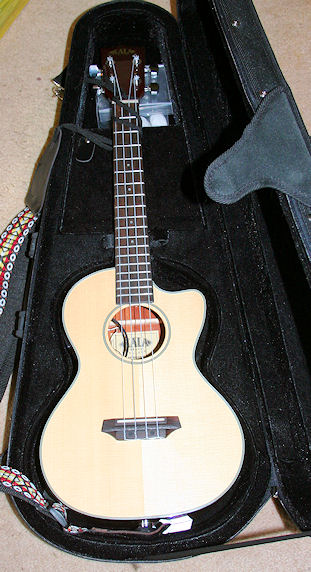
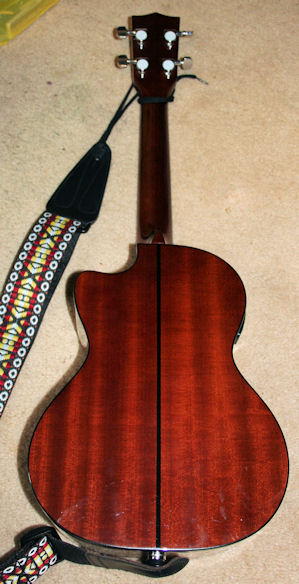
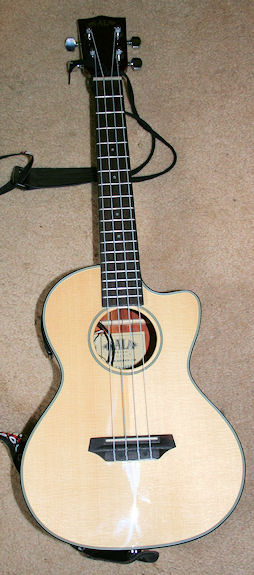
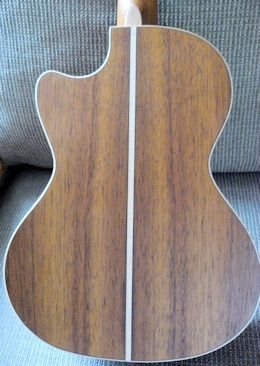
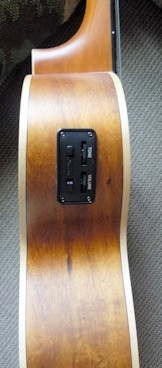
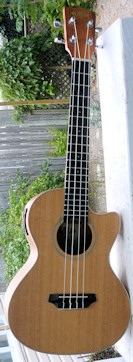
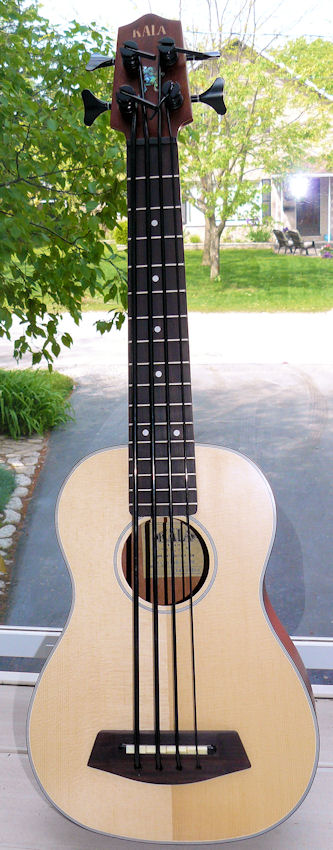
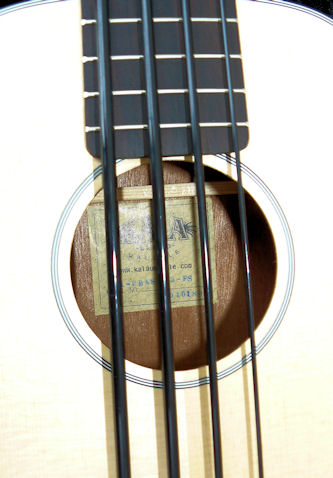
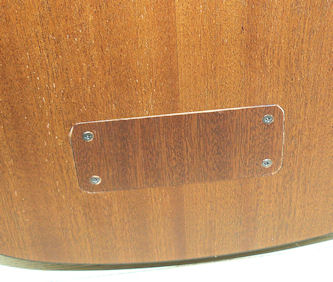
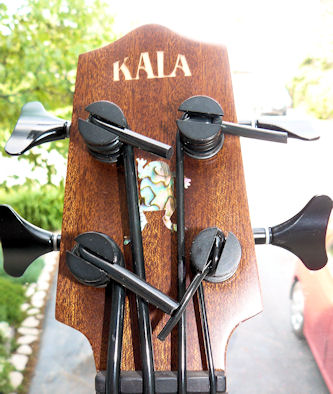
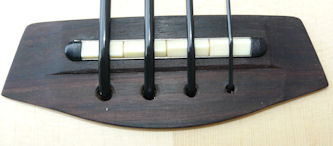
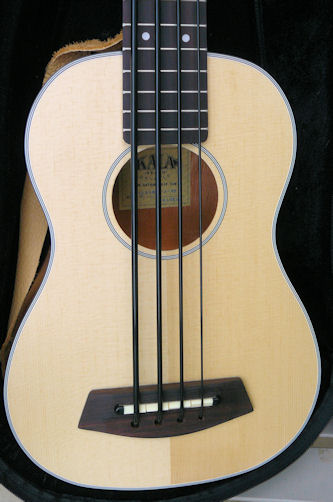
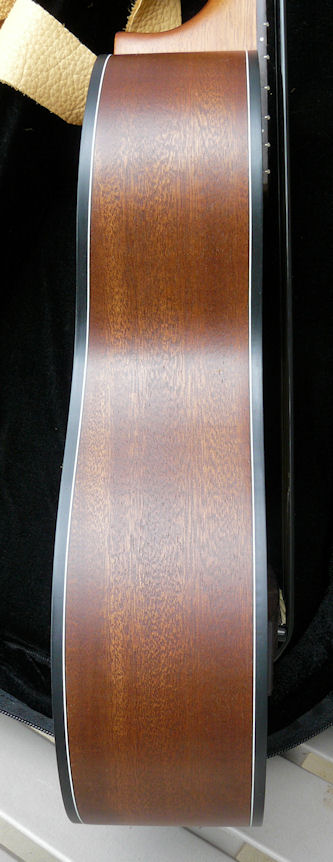
Kala
I have a huge amount of respect for Kala Brand Music and its founder, Mike Upton. Kala has been an innovative company dedicated to producing good, well-made but affordable ukuleles. They explore new woods and new designs. And they have great customer service.
My next instrument will be a Kala tenor resonator. It's taken me a while to warm up to it, but now I am anxious to own one. I actually made the two-and-a-half hour drive to Toronto to find one, earlier this year (2014) but they were out of stock everywhere. And worse, I was told none will be available in Canada until at least August! I was very disappointed, but live in hope to see one in my hands within the next six or eight months.
Spruce top tenor:
My first ukulele was this Kala solid spruce top, cutaway tenor with electric pickup (KA-STE). It has mahogany back and sides, but since it is not specified as solid, I suspect the back and sides are laminates. I don't mind laminates on the back and side, but I really prefer solid wood soundboards. The spruce gives a clear, bright tone.
I was completely unsure of what to expect, and only hoped for something that didn't disappoint me, but the Kala exceeded everything. It is beautifully made, with a brilliant gloss finish, nice binding and a solid wood (Sitka spruce) top. On top of that it came with a nice hard-shell case. This is the instrument that started me on this road.
I immediately noticed that the strings were tight, more so than my guitar. The tenor is the same tuning as the soprano, but with a longer scale length, it means the strings are stretched much tighter. This has two effects. First it makes the strings loud and bright. Second, they are tighter, so they don't bend as easily as soprano strings (and indeed guitar strings, especially electric). This was felt in my aching finger tips of my left hand: new calluses were forming.
Kalas are, from what I have seen and read online, one of the best 'production line' ukuleles around. They're made in China, but the build quality is very, very good based on the one I received. The finish is good, the neck smooth, the intonation good. The tuners are sealed, geared tuners.
Intonation is how well the frets line up with the notes you should produce at that location on the string. It's important because if it is not perfect, your notes will sound flat or sharp, not in tune. For a small neck, it's critical because even a minute distance from the right spot can affect play.
Plugging the guitar into an amp produces a bit of feedback through the piezo pickup and active electronics, but not an excessive amount unless you really crank up the volume. This Kala model comes with basic volume and tone controls through a built-in pre-amp. It uses a small, easily replaced battery for power. If you look at the photos, you can see the wiring running from the pre-amp to the pickup, visible through the sound hole. That's not very attractive. This wiring sometimes shifts and touches the back, causing a bit of a buzz. It's easily fixed by moving it by hand, but I will need to devise a permanent solution (or better yet, the factory should!).
Another source for buzzing was the pickup connector button on the bottom. It screws in and is easy to correct, but the entire assembly was loose when the Kala arrived. The connector, by the way, is a great place to hang a strap on. Unfortunately there isn't a second strap button, so you'll need a tie-on style strap that attaches to the head.
The cutaway design is non-traditional, but lets me reach higher frets more easily than I might be able to reach on a traditional figure-8 design.
The case is hard foam - good, light, albeit a teensy bit bulky: it has lots of room to carry other things, plus Velcro straps to hold the uke's neck safely in place. It has two external straps to it's easy to carry on your shoulder or back.
As an introduction to the world of ukuleles, this was probably the best choice I could have made.
A little note on
Kala's history. In 1995 Michael Upton started working for
Hohner. During his work as a sales rep, he noticed what he later
called, "a big gap in the market for ukuleles that were both
well-made and affordable." He decided to change that.
Upton launched his
Kala Brand
Music Co. in 2005, partnering with a factory in China to
build his instruments. Upton designed ukes with traditional
shapes and woods, but he also experimented, offering models with
non-traditional shapes and a wide variety of tonewoods. He
refined Kala's designs to produce instruments with thinner tops,
thinner bracing, and lighter machines.
Update: I had a chance to play a Kala spruce-top baritone at the Twelfth Fret, in Toronto in summer, 2012. I really liked the tone that come from it: very sweet compared to a mahogany baritone. Good sustain, too.
Would I purchase another Kala spruce? Yes.
Would I recommend them to others? Yes, without reservation.
Rating (0-5): ****.
Status: Sold to help finance another purchase.
Yes, I know, it was my first love, but one moves on...
NB: The strap did not come with the uke. It's my guitar strap. And it's too big and doesn't fit in the case very well, either. A smaller strap is recommended, see straps.
Cedar top tenor:
I had the opportunity, in mid-September, to play several ukes belonging to a uke aficionado I met on a uke forum. These included a vintage Regal, Bushman Jenny, a Sonny D and a Kala KA-TE-CT-C, which translates to tenor scale (T), solid cedar top and koa sides and back (CT), cutaway (C), electronics (E), and a satin finish, as well as a few others I've forgotten.
Of all the ukes this gentleman brought, I was most impressed with the Kala. I liked the satin finish, too. I thought it would be interesting to compare its sound with my Pono cedar top. I had decided at that point I wasn't getting enough play time from the Republic Resonator, so I sold it and ordered the Kala from Musicguymic (MGM). It arrived Sept. 26 after what must be the shortest-ever trip by mail from Hawaii.
First impressions: it's lovely, with a sweet sound that has a wonderful ringing sustain. This is surely a combination of the satin finish and the cedar top. The finish seems thin and light, almost unnoticeable. The top is solid cedar - which I have become increasingly fond of as a for ukuleles. It has a wonderful, warm but bright sound.
The sides and back are koa, laminated. It's quite attractive; the satin finish doesn't seem to redden the koa as much as some of the gloss finish ukes I've seen made of that wood. I am also becoming convinced that satin or matte finishes really have a different effect on the sound.
I really like the cutaway design. The projection is very good and quite loud. I think it sounds a bit better when I pick it than when I strum it, something I found with the Pono cedar previously. I think the longer sustain of cedar tends to muddy sound if too many strings are played at once, too often. Just a hypothesis, but the spruce top seems to sound clearer than the cedar when strummed.
The Kala cedar seems much lighter than the other Kala I own, and certainly a bit lighter than my Ponos. I'm not sure if that's just my imagination or if it's because it actually weighs less than the spruce top. Have to weigh it...
The head has sealed, geared tuners. The neck is smooth, straight and with excellent intonation, and well-dressed frets (and it's a narrow neck). The Kala came with Aquila strings which I really have come to appreciate.
The Kala has the same active pickup and small pre-amp with tone and volume controls as the spruce top (above). The battery is very easy to remove and replace. The output jack doubles as a strap peg.
Comparing the Kala's tone with the Pono cedar, the Kala seems a bit thinner, with somewhat less sustain, and fewer low-end tones, but also a bit brighter and louder than the Pono. Once again, it's different from all the other ukuleles I own. That's the amazing thing about ukes: every model is different. That's an excuse to own more, I suppose. Update: See my review of the Mainland cedar tenor.
This is a really lovely instrument. My first impressions were correct and I was pleased to be able to add it to my collection. Over the past few months, I have come to like the crisp sound of this uke more than many of the others I have, so I play it often.
I should add that this uke came with the same light but bulky foam-padded case the spruce top came with. I will likely get another Kala in the future, but I am not sure about which model to choose. Possibly the acacia? or the U-bass? Decisions, decisions... (May 2010: U-bass ordered...)
Would I purchase another Kala cedar? Yes.
Would I recommend them to others? Yes, without reservation.
Rating (0-5): ****1/2 for the cedar.
Status: Still owned and played often, but for sale.
U-Bass
I just took delivery of a spruce-topped Kala U-bass a baritone (20") scale acoustic bass. Not a full review yet - too early. Will come shortly. Not even many photos, just some preliminary out-of-the-box shots. I simply wanted to put notice in here that it had arrived.
Back in the Paleozoic of my musical life (not the real Paleozoic, which ended roughly 250 million years ago - I'm not that old), I used to play bass. The first band I was in (mid 1960s) needed a bass player. I could barely play guitar, only had a Kent six-string electric and a cheap amp, but I said I could play and they let me join. I played bass on the last four strings of the guitar. Wasn't very low or deep, and now and then I'd stray onto the first two strings and get everyone angry at me, but I was listed as the band's bass player. After a year or two, I joined another band as a rhythm player and found my niche. But I never forgot that first stint as the "bass" player without a bass guitar. Years later, I'd own and play several bass guitars (the short-scale - 25" -Supro was my favourite), but my first experience was as a guitar player faking it.
I've seen and tinkered with acoustic basses in local music stores. Almost bought one (the full size ones are actually less expensive than the little Kala). But I couldn't justify one for the amount of bass I would play. Then Kala announced its U-bass and I watched it with great interest, reading forums and reviews carefully to try and figure out if I'd like one.
The size was right (a 20" scale, same as a baritone uke) and it whispered "ukulele" in my ear. How could I resist such a siren song?
I had previously considered the somewhat smaller Ashbory bass, but comments on some forums suggested it had problems with strings always stretching. And he Ashbory is solid-body, so is pretty much silent when not plugged in. The Kala is quiet, but it can be heard unplugged, at least by the player (in a quiet room).
Here it is. It arrived the Friday morning before the May 24th long weekend in Canada, so I had some time to play with it. Spent the first hour or more tuning it - the strings slip a lot at first. But they settled in after a couple of days (moving it in and out of the gig bag untuned it a lot - the tuner heads don't have a lot of room in there).
I played it solo, and also played along with a few loops on my eBand amp. The eBand's little speakers are not up to the bass output, so I took it downtown to Blue Mountain Music, Saturday, and plugged it into one of their bass amps.
Wow. What a sound. Fat. I mean really rotund! Great organic, wet, slappy stand-up bass sound. Gobs of sound. People stopped by the open door and stared at it as I plucked along. No one expected such a sound from a little instrument. This bass would have brought a smile to Charlie Mingus. Got lots of positive comments from passers-by.
The U-bass is the result of a joint effort by Kala's Mike Upton and Road Toad Music's Owen Holt. Road Toad has been known for its custom - beautiful and expensive - acoustic basses, but the Kala is aimed at affordability. Prices on eBay are around $400 US, more if you get a case. In Canada it's close to $500 (I got mine from Ukulele Junky in Montreal, a good seller). I ended up with the solid spruce top, but there is an acacia around the price, and a mahogany model for $525 US. Mine came with a soft gig bag, which is a tight fit because of the wide tuners.
It comes in both fretted and fretless versions. I got the fretted because my skills are too low for a fretless, but also because I worry that the short scale would make it tough to be accurate without frets to guide me. But it sounds fretless, so I get the best of both worlds.
First impressions: light, easy to play although the strings squirm a but under my fingertips. Definitely needs a strap if you play standing up and not merely Lori's delightful Uke Leash. You need both ends supported so you can work your hands freely. It's about as thick as a baritone uke, so it's not very deep. The short scale makes it easy to reach notes all over the fretboard.
There are no controls for tone or volume so the amp does all the work processing the signal. Kala notes that each string has its own independent, passive piezo pickup made by Shadow (under a compensated saddle). I'm a geeky electronics guy, so my wish list would include controls for each pickup so the player could balance the output somewhat better. I found the D and G strings were a bit hotter than the E and A strings and would have liked to equalize them a bit.
The strings are Pahoehoe polyurethane named after a black, ropey lava common to Hawaii. They're fat, have a tendency to squirm, and my fingers don't glide on them easily. It takes a bit of time to develop the proper technique of firm, but insistent, pressure to keep them in place, and then lifting up off the strings a bit to to slide. At least you don't need talc, like with the Ashbory strings.
Strings are expensive - around $25-$30 a set on eBay. I don't know how long they last, since I doubt anyone has had a U-bass long enough to wear out a set.
Action and intonation are very good. The strings look a little high at the 12th fret, but given the thickness of the strings and the way you play bass, they're fine. The Hipshot geared tuners are very precise.
The spruce top is okay, but mine is poorly book-matched. The differences between the two halves are quite noticeable.
On the back (laminate mahogany), there's a patch you have to unscrew to replace strings. It's rough and not even close in colour and grain to the rest (see photo). The only saving grace is that's not usually visible, but it looks like a homebrew afterthought. I understand the reason for it, but those tiny wood screws are likely to get lost and having to unscrew the back is clumsy and inefficient. I would urge Kala to work on a more sophisticated means to provide a port for stringing. And to try to match the woods a little better if a cover is needed.
It's a satin finish, which is okay, but I would lean towards gloss for this instrument.
It's certainly not a toy. The U-bass is currently on tour with Simon and Garfunkel (well actually with bassist Bakithi Kuma) so it has a place in pro performances. But it's also accessible for us home pluckers. As long as you have an amp, of course.
More to follow. Kala has just announced a new solid-body U-bass now selling in 2011. (Saw a couple at Twelfth Fret, in Toronto, June 2012 - almost bought one but decided I don't get enough bass practice as it is, so I'll wait.)
Update: An alternative is the Beaver Creek travel bass, which uses metal strings and is much louder unplugged. Having played both, I lean towards the Beaver Creek. It sounds more like an acoustic bass, without the fat sounds of the U-bass, but at half the price, it's a good buy.
Another option: there are still a few 25" scale basses around, although few made today. Most seem to be used, and find their way to eBay. For "short-scale" (30.5" - which is still a bit long for me) basses, I picked up an Epiphone Viola bass at Blue Mountain Music on a sale for $220.
Would I purchase another Kala U-bass? Possibly a mahogany or
acacia model, and very possibly a solid-body but I'd only ever own one at a time.
Would I recommend them to others? Yes, especially to bass players.
Rating (0-5): ***1/2 for cosmetics, ****1/2 for sound.
Status: Sold.
Solid Acacia and Travel Ukes
I didn't buy these ukes, but in late July, 2010, I had a chance to play both of them recently at Broadway Music, in Orangeville. We stopped there on our way home from Toronto and I had some fun tinkering with their rather large uke collection.
The Travel Uke has a solid spruce top and a slightly bowed back. I suppose that might help it reflect sound from the very thin body. For an instrument so thin, it was surprisingly loud, although the richness of the tone was somewhat lacking. It's also a bit unbalanced, with the neck and head a little too heavy for the body weight. But I liked it and, had it come with a pickup installed, I might have bought one right away.
Kala's beautiful acacia wood uke has always appealed to me. It has a slotted headstock, with delicately intricate fretboard inlay markers. The wood is beautiful, a match for most koa instruments. Again, it was only acoustic and I want pickups on my instruments, so I had to pass on it. The sound was also very close to my Kala cedar-top/koa sided uke (above). I love the cedar already, but don't know if I want two that sound so close. Either seems to be a good addition to any collection, but my cedar-top has a pickup.
